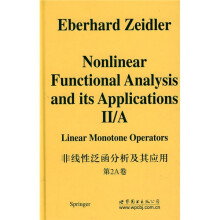非线形泛函分析及其应用:线性单调算子(第2A卷)

目 录内容简介
Preface to Part II/A
INTRODUCTION TO THE SUBJECT
CHAPTER 18
Variational Problems, the Ritz Method, and
the Idea of Orthogonality
18.1. The Space C(G) and the Variational Lemma
18.2. Integration by Parts
18.3. The First Boundary Value Problem and the Ritz Method
18.4. The Second and Third Boundary Value Problems and
the Ritz Method
18.5. Eigenvalue Problems and the Ritz Method
18.6. The H61der Inequality and its Applications
18.7. The History of the Dirichlet Principle and Monotone Operators
18.8. The Main Theorem on Quadratic Minimum Problems
18.9. The Inequality of Poincar6-Friedrichs
18.10. The Functional Analytic Justification of the Dirichlet Principle
18.11. The Perpendicular Principle, the Riesz Theorem, and
the Main Theorem on Linear Monotone Operators
18.12. The Extension Principle and the Completion Principle
18.13. Proper Subregions
18.14. The Smoothing Principle
18.15. The Idea of the Regularity of Generalized Solutions and
the Lemma of Weyl
18.16. The Localization Principle
18.17. Convex Variational Problems, Elliptic Differential Equations,
and Monotonicity
18.18. The General Euler-Lagrange Equations
18.19. The Historical Development of the 19th and 20th Problems of
Hilbert and Monotone Operators
18.20. Sufficient Conditions for Local and Global Minima and
Locally Monotone Operators
CHAPTER 19
The Galerkin Method for Differential and Integral Equations,
the Friedrichs Extension, and the Idea of Self-Adjointness
19.1. Elliptic Differential Equations and the Galerkin Method
19.2. Parabolic Differential Equations and the Galerkin Method
19.3. Hyperbolic Differential Equations and the Galerkin Method
19.4. Integral Equations and the Galerkin Method
!9.5. Complete Orthonormal Systems and Abstract Fourier Series
19.6. Eigenvalues of Compact Symmetric Operators
(Hilbert-Schmidt Theory)
19.7. Proof of Theorem 19.B
19.8. Self-Adjoint Operators
19.9. The Friedrichs Extension of Symmetric Operators
19.10. Proof of Theorem 19.C
19.11. Application to the Poisson Equation
19.12. Application to the Eigenvalue Problem for the Laplace Equation
19.13. The Inequality of Poincar6 and the Compactness
Theorem of Rellich
19.14. Functions of Self-Adjoint Operators
19.15. Application to the Heat Equation
19.16. Application to the Wave Equation
19.17. Semigroups and Propagators, and Their Physical Relevance
19.18. Main Theorem on Abstract Linear Parabolic Equations
!9.19. Proof of Theorem 19.D
!9.20. Monotone Operators and the Main Theorem on
Linear Nonexpansive Semigroups
19.21. The Main Theorem on One-Parameter Unitary Groups
19.22. Proof of Theorem 19.E
19.23. Abstract Semilinear Hyperbolic Equations
19.24. Application to Semilinear Wave Equations
19.25. The Semilinear Schr6dinger Equation
19.26. Abstract Semilinear Parabolic Equations, Fractional Powers of
Operators, and Abstract Sobolev Spaces
19.27. Application to Semilinear Parabolic Equations
19.28. Proof of Theorem 19.1
19.29. Five General Uniqueness Principles and Monotone Operators
19.30. A General Existence Principle and Linear Monotone Operators
CHAPTER 20
Difference Methods and Stability
20.1. Consistency, Stability, and Convergence
20.2. Approximation of Differential Quotients
20.3. Application to Boundary Value Problems for
Ordinary Differential Equations
20.4. Application to Parabolic Differential Equations
20.5. Application to Elliptic Differential Equations
20.6. The Equivalence Between Stability and Convergence
20.7. The Equivalence Theorem of Lax for Evolution Equations
LINEAR MONOTONE PROBLEMS
CHAPTER 21
Auxiliary Tools and the Convergence of the Galerkin
Method for Linear Operator Equations
21.1. Generalized Derivatives
21.2. Sobolev Spaces
21.3. The Sobolev Embedding Theorems
21.4. Proof of the Sobolev Embedding Theorems
21.5. Duality in B-Spaces
21.6. Duality in H-Spaces
21.7. The Idea of Weak Convergence
21.8. The Idea of Weak* Convergence
21.9. Linear Operators
21.10. Bilinear Forms
21.11. Application to Embeddings
21.12. Projection Operators
21.13. Bases and Galerkin Schemes
21.14. Application to Finite Elements
21.15. Riesz-Schauder Theory and Abstract Fredholm Alternatives
21.16. The Main Theorem on the Approximation-Solvability of Linear
Operator Equations, and the Convergence of the Galerkin Method
21.17. Interpolation Inequalities and a Convergence Trick
21.18. Application to the Refined Banach Fixed-Point Theorem and
the Convergence of Iteration Methods
21.19. The Gagliardo-Nirenberg Inequalities
21.20. The Strategy of the Fourier Transform for Sobolev Spaces
21.21. Banach Algebras and Sobolev Spaces
21.22. Moser-Type Calculus Inequalities
21.23. Weakly Sequentially Continuous Nonlinear Operators on
Sobolev Spaces
CHAPTER 22
Hilbert Space Methods and Linear Elliptic Differential Equations
22.1. Main Theorem on Quadratic Minimum Problems and the
Ritz Method
22.2. Application to Boundary Value Problems
22.3. The Method of Orthogonal Projection, Duality, and a posteriori
Error Estimates for the Ritz Method
22.4. Application to Boundary Value Problems
22.5. Main Theorem on Linear Strongly Monotone Operators and
the Galerkin Method
22.6. Application to Boundary Value Problems
22.7. Compact Perturbations of Strongly Monotone Operators,
Fredholm Alternatives, and the Galerkin Method
22.8. Application to Integral Equations
22.9. Application to Bilinear Forms
22.10. Application to Boundary Value Problems
22.11. Eigenvalue Problems and the Ritz Method
22.12. Application to Bilinear Forms
22.13. Application to Boundary-Eigenvalue Problems
22.14. Garrding Forms
22.15. The Garding Inequality for Elliptic Equations
22.16. The Main Theorems on Garding Forms
22.17. Application to Strongly Elliptic Differential Equations of Order 2m
22.18. Difference Approximations
22.19. Interior Regularity of Generalized Solutions
22.20. Proof of Theorem 22.H
22.21. Regularity of Generalized Solutions up to the Boundary
22.22. Proof of Theorem 22.I
CHAPTER 23
Hilbert Space Methods and Linear Parabolic Differential Equations
23.1. Particularities in the Treatment of Parabolic Equations
23.2. The Lebesgue Space Lp(0, T; X) of Vector-Valued Functions
23.3. The Dual Space to Lp(O, T;X)
23.4. Evolution Triples
23.5. Generalized Derivatives
23.6. The Sobolev Space Wp(0, T; V, H)
23.7. Main Theorem on First-Order Linear Evolution Equations and
the Galerkin Method
23.8. Application to Parabolic Differential Equations
23.9. Proof of the Main Theorem
CHAPTER 24
Hilbert Space Methods and Linear Hyperbolic
Differential Equations
24.1. Main Theorem on Second-Order Linear Evolution Equations
and the Galerkin Method
24.2. Application to Hyperbolic Differential Equations
24.3. Proof of the Main Theorem
INTRODUCTION TO THE SUBJECT
CHAPTER 18
Variational Problems, the Ritz Method, and
the Idea of Orthogonality
18.1. The Space C(G) and the Variational Lemma
18.2. Integration by Parts
18.3. The First Boundary Value Problem and the Ritz Method
18.4. The Second and Third Boundary Value Problems and
the Ritz Method
18.5. Eigenvalue Problems and the Ritz Method
18.6. The H61der Inequality and its Applications
18.7. The History of the Dirichlet Principle and Monotone Operators
18.8. The Main Theorem on Quadratic Minimum Problems
18.9. The Inequality of Poincar6-Friedrichs
18.10. The Functional Analytic Justification of the Dirichlet Principle
18.11. The Perpendicular Principle, the Riesz Theorem, and
the Main Theorem on Linear Monotone Operators
18.12. The Extension Principle and the Completion Principle
18.13. Proper Subregions
18.14. The Smoothing Principle
18.15. The Idea of the Regularity of Generalized Solutions and
the Lemma of Weyl
18.16. The Localization Principle
18.17. Convex Variational Problems, Elliptic Differential Equations,
and Monotonicity
18.18. The General Euler-Lagrange Equations
18.19. The Historical Development of the 19th and 20th Problems of
Hilbert and Monotone Operators
18.20. Sufficient Conditions for Local and Global Minima and
Locally Monotone Operators
CHAPTER 19
The Galerkin Method for Differential and Integral Equations,
the Friedrichs Extension, and the Idea of Self-Adjointness
19.1. Elliptic Differential Equations and the Galerkin Method
19.2. Parabolic Differential Equations and the Galerkin Method
19.3. Hyperbolic Differential Equations and the Galerkin Method
19.4. Integral Equations and the Galerkin Method
!9.5. Complete Orthonormal Systems and Abstract Fourier Series
19.6. Eigenvalues of Compact Symmetric Operators
(Hilbert-Schmidt Theory)
19.7. Proof of Theorem 19.B
19.8. Self-Adjoint Operators
19.9. The Friedrichs Extension of Symmetric Operators
19.10. Proof of Theorem 19.C
19.11. Application to the Poisson Equation
19.12. Application to the Eigenvalue Problem for the Laplace Equation
19.13. The Inequality of Poincar6 and the Compactness
Theorem of Rellich
19.14. Functions of Self-Adjoint Operators
19.15. Application to the Heat Equation
19.16. Application to the Wave Equation
19.17. Semigroups and Propagators, and Their Physical Relevance
19.18. Main Theorem on Abstract Linear Parabolic Equations
!9.19. Proof of Theorem 19.D
!9.20. Monotone Operators and the Main Theorem on
Linear Nonexpansive Semigroups
19.21. The Main Theorem on One-Parameter Unitary Groups
19.22. Proof of Theorem 19.E
19.23. Abstract Semilinear Hyperbolic Equations
19.24. Application to Semilinear Wave Equations
19.25. The Semilinear Schr6dinger Equation
19.26. Abstract Semilinear Parabolic Equations, Fractional Powers of
Operators, and Abstract Sobolev Spaces
19.27. Application to Semilinear Parabolic Equations
19.28. Proof of Theorem 19.1
19.29. Five General Uniqueness Principles and Monotone Operators
19.30. A General Existence Principle and Linear Monotone Operators
CHAPTER 20
Difference Methods and Stability
20.1. Consistency, Stability, and Convergence
20.2. Approximation of Differential Quotients
20.3. Application to Boundary Value Problems for
Ordinary Differential Equations
20.4. Application to Parabolic Differential Equations
20.5. Application to Elliptic Differential Equations
20.6. The Equivalence Between Stability and Convergence
20.7. The Equivalence Theorem of Lax for Evolution Equations
LINEAR MONOTONE PROBLEMS
CHAPTER 21
Auxiliary Tools and the Convergence of the Galerkin
Method for Linear Operator Equations
21.1. Generalized Derivatives
21.2. Sobolev Spaces
21.3. The Sobolev Embedding Theorems
21.4. Proof of the Sobolev Embedding Theorems
21.5. Duality in B-Spaces
21.6. Duality in H-Spaces
21.7. The Idea of Weak Convergence
21.8. The Idea of Weak* Convergence
21.9. Linear Operators
21.10. Bilinear Forms
21.11. Application to Embeddings
21.12. Projection Operators
21.13. Bases and Galerkin Schemes
21.14. Application to Finite Elements
21.15. Riesz-Schauder Theory and Abstract Fredholm Alternatives
21.16. The Main Theorem on the Approximation-Solvability of Linear
Operator Equations, and the Convergence of the Galerkin Method
21.17. Interpolation Inequalities and a Convergence Trick
21.18. Application to the Refined Banach Fixed-Point Theorem and
the Convergence of Iteration Methods
21.19. The Gagliardo-Nirenberg Inequalities
21.20. The Strategy of the Fourier Transform for Sobolev Spaces
21.21. Banach Algebras and Sobolev Spaces
21.22. Moser-Type Calculus Inequalities
21.23. Weakly Sequentially Continuous Nonlinear Operators on
Sobolev Spaces
CHAPTER 22
Hilbert Space Methods and Linear Elliptic Differential Equations
22.1. Main Theorem on Quadratic Minimum Problems and the
Ritz Method
22.2. Application to Boundary Value Problems
22.3. The Method of Orthogonal Projection, Duality, and a posteriori
Error Estimates for the Ritz Method
22.4. Application to Boundary Value Problems
22.5. Main Theorem on Linear Strongly Monotone Operators and
the Galerkin Method
22.6. Application to Boundary Value Problems
22.7. Compact Perturbations of Strongly Monotone Operators,
Fredholm Alternatives, and the Galerkin Method
22.8. Application to Integral Equations
22.9. Application to Bilinear Forms
22.10. Application to Boundary Value Problems
22.11. Eigenvalue Problems and the Ritz Method
22.12. Application to Bilinear Forms
22.13. Application to Boundary-Eigenvalue Problems
22.14. Garrding Forms
22.15. The Garding Inequality for Elliptic Equations
22.16. The Main Theorems on Garding Forms
22.17. Application to Strongly Elliptic Differential Equations of Order 2m
22.18. Difference Approximations
22.19. Interior Regularity of Generalized Solutions
22.20. Proof of Theorem 22.H
22.21. Regularity of Generalized Solutions up to the Boundary
22.22. Proof of Theorem 22.I
CHAPTER 23
Hilbert Space Methods and Linear Parabolic Differential Equations
23.1. Particularities in the Treatment of Parabolic Equations
23.2. The Lebesgue Space Lp(0, T; X) of Vector-Valued Functions
23.3. The Dual Space to Lp(O, T;X)
23.4. Evolution Triples
23.5. Generalized Derivatives
23.6. The Sobolev Space Wp(0, T; V, H)
23.7. Main Theorem on First-Order Linear Evolution Equations and
the Galerkin Method
23.8. Application to Parabolic Differential Equations
23.9. Proof of the Main Theorem
CHAPTER 24
Hilbert Space Methods and Linear Hyperbolic
Differential Equations
24.1. Main Theorem on Second-Order Linear Evolution Equations
and the Galerkin Method
24.2. Application to Hyperbolic Differential Equations
24.3. Proof of the Main Theorem
目 录内容简介
自1932年,波兰数学家Banach发表第一部泛函分析专著“Theorie des operations lineaires”以来,这一学科取得了巨大的发展,它在其他领域的应用也是相当成功。如今,数学的很多领域没有了泛函分析恐怕寸步难行,不仅仅在数学方面,在理论物理方面的作用也具有同样的意义,M.Reed和B.Simon的“Methods of Modern MathematicalPhysjcs”在前言中指出:“自1926年以来,物理学的前沿已与日俱增集中于量子力学,以及奠定于量子理论的分支:原子物理、核物理固体物理、基本粒子物理等,而这些分支的中心数学框架就是泛函分析。”所以,讲述泛函分析的文献已浩如烟海。而每个时代,都有这个领域的代表性作品。
比价列表
公众号、微信群
 缺书网
缺书网微信公众号
 扫码进群
扫码进群实时获取购书优惠






